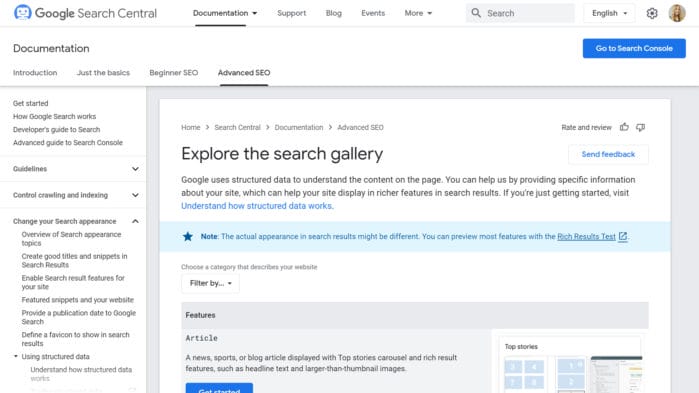Structured data helps search engines better understand your website content. The more context you can give Google, the better it can match your data to a user’s search query.
When content is marked up with certain schema.org types and properties, that information is eligible for rich results and other search enhancement features. The benefits of structured data are clear, but there are still several myths and misconceptions that deter users from investing in this advanced SEO practice.
This article debunks those myths so that you’ll have a better understanding of what structured data markup is and what it can do.
Myth #1: Structured data guarantees rich results in search
Structured data does not guarantee you will receive a rich result. While it enables certain search features, such as review stars and recipe cards, ultimately, Google decides whether or not to award the rich result. In order to maximize the opportunity to receive a rich result, consider following these best practices:
Google’s Required and Recommended Properties
Include all of Google’s required properties and any recommended properties that could further enhance your data in search. Different schema.org types have different required and recommended properties. Missing recommended properties means your rich results won’t be as robust; however, missing required properties means your content will not be eligible for rich results at all.
Many times the warnings from missing recommended properties are due to that content not being on the page. For example, certain eCommerce stores may not have stock keeping units ( SKU) for their inventory. This is a recommended property for product markup according to Google’s documentation, but since it isn’t applicable and therefore doesn’t exist on the page, it won’t be included in the schema markup.
To determine whether there is a rich result opportunity within your content and which rich result opportunity you should optimize for with schema markup, try exploring the Search Gallery. Dive deeper into your chosen rich result opportunity with the links provided.
Follow the Rules of Structured Data
Make sure you’re not in violation of any of Google’s content or technical guidelines. Each rich result has different guidelines that must be followed. For example, FAQs shouldn’t be used for advertising purposes, and reviews for local businesses must be visible to users visiting the site.
To check the health of your schema markup, we recommend the following tools:
Schema Markup Validator (SMV)
The Schema Markup Validator (SMV) is currently in beta but has officially replaced Google’s Structured Data Testing Tool (SDTT). Many SEOs still prefer the SDTT, as the SMV does not yet show warnings and only validates schema syntax, not rich result eligibility.
The service, provided by Google for the schema.org community, can validate schema.org-based structured data embedded in web pages, otherwise known as schema markup. The SMV has the ability to extract JSON-LD, RDFa, and Microdata markup, display a summary of the extracted structured data and identify syntax mistakes in the markup.
Learn more about the SMV in our news post here.
Rich Results Test (RRT)
The Rich Results Test (RRT) lets you test your web pages to see which rich results your structured data markup is eligible for.
Revise your Content for More Rich Result Opportunities
If Google is still not awarding a rich result, consider revising your content. Is there room for more information to support E-E-A-T on the subject? Does the content need to be edited down? Ensuring your content provides the best answers to the queries you’re looking to rank for may influence your ability to achieve rich results.
Myth #2: Structured data is a ranking factor in search engine page results
This is a tricky question, but ultimately structured data is not a direct ranking factor in search. Google’s John Mueller clarifies what structured data actually does:
Just because people are applying structured data in a technically correct way, does not mean that the page will perform better than it would otherwise, and, therefore cannot guarantee a higher rank. That being said, we’ve found that applying structured data—particularly for rich result eligibility—increases engagement with content which can result in increased ranking over time.
It’s important to remember that structured data explicitly defines entities on a page and how they relate to one another, which can help convey a page’s meaning. However, this should always be secondary to creating quality content.
Myth #3: Structured data is just an SEO strategy
While structured data does improve your search engine optimization performance, it is not solely an SEO strategy. It is much more than that.
Structured data markup translates your content into JSON-LD, a language that search engines can understand. The more that Google understands, the better it can match your content to a user’s search query. You’re actually taking control of how the data on your web pages is defined rather than just hoping that search engines will be intuitive enough to decipher your content and show the best information in search results. We’ve helped many companies, like SAP and AdventHealth, tie results from structured data markup back to their online business goals. SAP achieved more than 400% net growth in organic traffic from rich results, and AdventHealth experienced a 90% increase in clicks, a 38% increase in CTR, and a top position in the rankings across all web pages.
Myth #4: Google can figure it out without the extra work
Google is pretty smart at figuring things out, but leaving a search engine to do everything on its own may not yield the organic search results you’re looking for. Search engines can analyze your web pages without structured data markup, sure, but you won’t have much control over what information will be displayed in search. With the right content and comprehensive schema markup, Google can better understand how you want your data to be interpreted.
Moreover, Google won’t give you certain search enhancement features without proper structured data implementation, such as recipes, jobs, and events, which can hurt your search engine optimization performance in the long run.
The truth about structured data
Now that we’ve debunked some of the myths about structured data, here is the truth about it. Since 2014, Google’s Documentation has recommended adding structured data to your site to increase findability in search.
“You can help us by providing explicit clues about the meaning of a page to Google by including structured data on the page. “
Structured data is a standardized format for providing information about a page, and schema.org is the dictionary. Schema.org is a semantic vocabulary that when used for structured data is called schema markup. By using structured data markup like schema markup, you are translating your human-readable content into a language that search engines understand.
You can use schema markup to effectively define objects on your web pages as entities with their own properties and relationships to other entities. Once defined, you can link your entities to a search engine’s knowledge graph. Knowledge graphs represent the linking of all information across the Web, and joining that network means that Google will better understand and contextualize your content. This leads to all sorts of search enhancements, such as enhancing your Google Knowledge Panel.
While there are many benefits to marking up your content, here are some of our favourites:
1. Own the customer experience from the beginning of their journey.
Structured data gives you more control over the way your brand is represented. Being in control means you can define exactly how you want your brand content to be understood, easily test different strategies, and control where and how the structured data is distributed to your websites.
For example, our work with Home Hardware resulted in a 190% increase in clicks quarter-over-quarter from product rich results, which have become an integral part of the company’s online presence. Now, Home Hardware can inform and engage with customers directly through search engine page results with these enhancement features.
2. Show additional information in search through rich results and enhanced Google features.
Rich results are additional information coupled with eye-catching visuals that attract your attention in search. They bring your content alive, plus they take up more real estate in the search results pages, helping you outshine your competition. How do you get these rich results? By adding structured data to your website. There are 32 rich results to help your brand stand out in organic search, all of which can be enabled using structured data.
3. Take advantage of enhanced analytics to monitor all aspects of your organic search performance.
Once structured data is on your website, you can pull any of the schema.org properties you’ve marked up into your analytics platform (like Google Analytics) to drive better decisions with the context of the content. Schema App’s Enhanced Analytics adds schema.org properties into Google Analytics to show different levels of performance for your structured data.
Learn more about the benefits of structured data beyond SEO in our article 8 Benefits of Schema Markup and Why It’s Important for SEO.
We want your schema markup to be successful! What makes Schema App so effective is that we work with you to develop a customized strategy based on your business goals. From small businesses to enterprise companies, we have solutions that can integrate with any content management system.
Discover what structured data can do for you!
Set up a call with our technical experts today.

Jarod Colautti is a Senior Customer Success Manager. Schema App is an end-to-end Schema Markup solution that helps enterprise SEO teams create, deploy and manage Schema Markup to stand out in search.





